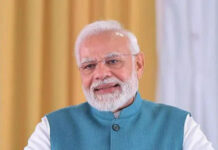After a contraction in the current financial year, India’s economy is forecast to bounce back with a sharp growth rate of 9.5 per cent next year provided it avoids further deterioration in financial sector health, Fitch Ratings said on Wednesday. The coronavirus pandemic will lead to shrinking of the already slowing economy in 2020-21 that started in April. Fitch Ratings forecast a 5 per cent contraction in the GDP in the ongoing financial year. “The pandemic has drastically weakened India’s growth outlook and laid bare the challenges caused by a high public-debt burden,” Fitch Ratings said in its APAC Sovereign Credit Overview released on Wednesday. “After the global crisis, India’s GDP growth is likely to return to higher levels than ”BBB” category peers, provided it avoids further deterioration in financial sector health as a result of the pandemic,” it said forecasting a 9.5 per cent real GDP growth next year. India on March 25 instituted the world’s largest lockdown to combat the novel coronavirus, halting almost all economic activities. The lockdown has been repeatedly extended, although some restrictions have been eased from May 4 in zones with fewer infections. “However, new cases have continued to rise,” it said. To support the economy, the Reserve Bank of India (RBI) has eased monetary policy by cutting policy rates and providing liquidity through long-term repo operations. Prudential requirements for banks have also been eased to free up liquidity for lending. “The government has announced stimulus measures amounting to 10 per cent of GDP, of which the fiscal component of about 1 per cent of GDP is significantly less than many of India’s peers,” the rating agency said. General government debt already stood at 70 per cent of GDP in 2019-20, well above the ”BBB” rating median of 42 per cent. India’s ratio of public debt/GDP is expected to rise to 84 per cent of GDP in 2020-21 – up from a forecast of 71 per cent when Fitch Ratings affirmed the ”BBB-” rating in December 2019. “This is based on our expectation of slower economic growth in FY21 and wider fiscal deficits, assuming that the government’s fiscal response remains restrained,” it said. “The credit profile is strengthened by relative external resilience stemming from solid foreign-reserve buffers, but weakened by some lagging structural factors, including governance indicators and GDP per capita.” Listing positives for India, Fitch Ratings said there was greater confidence in a sustained reduction in general government debt over the medium term to a level closer to the ”BBB” peer median. Also, there is a possibility of higher sustained investment and growth rates without the creation of macroeconomic imbalances, such as from successful structural reform implementation. Among the negatives was a material increase in the fiscal deficit, causing the gross general government debt/GDP ratio to be placed on a sustained upward trajectory. Other negative was loose macroeconomic policy settings that cause a return of persistently high inflation and widening current-account deficits, which would increase the risk of external funding stress, it said.

Dogra Herald is the media of J & K, breaking language and geographical barriers, connecting J & K to the rest of India.
0191 245 4946
info@dograherald.com
Latest articles
Akhilesh Yadav slams Centre over hiked traffic fines
iamjkstarr - 0
Samajwadi Party (SP) chief Akhilesh Yadav on Thursday slammed the Centre for imposing steep penalties on commuters under the amended Motor Vehicle Act 2019,...
Sakeena Itoo reviews preparations for Int’l Women’s Day celebration across J&K
Advocates recognition, celebration of contributions of womenfolk
DH NEWS SERVICEJAMMU, Feb 28Minister for Health and Medical Education, Social Welfare...
NHRC seeks report from Centre, States on sexual harassment cases
iamjkstarr - 0
The National Human Rights Commission has issued notices to the Centre, all States and Union Territories seeking reports on the Standard Operating Procedures, SOPs...


























